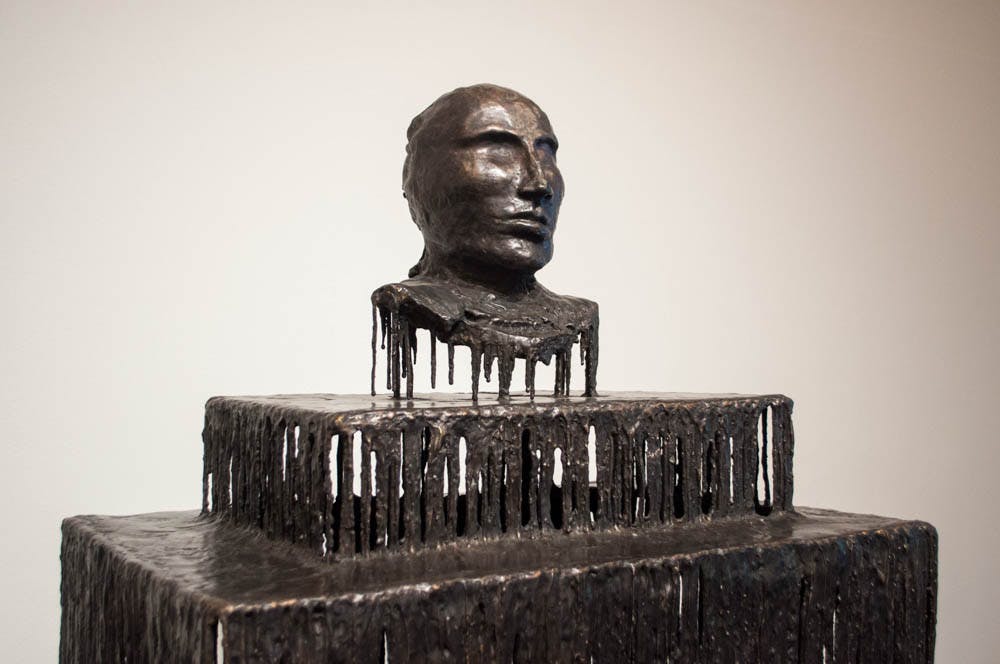Sept. 3rd, the David Winton Bell Gallery opened its latest exhibition, “Phantom Limb,” which features the work of Syrian-American artist Diana Al-Hadid. Sept. 16th, Al-Hadid came to Brown to give a lecture offering insights on her creative process and art.
Her work is comparable to the ruins of Renaissance statues, if those statues were flexible creations that could melt on a pedestal, dissolve mid-way into long strands curtaining the floor or levitate from the ground. The statues at the Winton Bell Gallery could resemble such vestiges of the past had Europeans tumbling out of the Middle Ages expressed an interest in treating materials like Al-Hadid does.
“The interpretation of my work as ruinous comes from my method and process rather than any conscious decision to prioritize a certain image,” Al-Hadid said. “By the time I’m through with my process, the materials are hard to recognize.” Al-Hadid uses a wide range of inputs to construct her sculptures and paintings including plaster, wood, foam, fiberglass, concrete, bronze, aluminum foil and a material called polymer gypsum, which she uses to create her distinctive drips. These drips are almost omnipresent in her work, giving paintings and sculptures alike an almost post-apocalyptic feel. “Her work is very unusual, very aesthetically pleasing,” said Meghan Hershkowitz ’19. “You don’t have to be a connoisseur of arts to enjoy it.”
The artwork seems impossibly delicate, quietly violent and gives off a feeling of brutal romanticism through a combination of Al-Hadid’s careful attention to structure and her ability to bend the perception of materials to almost unrecognizable levels. When she feels that her statues need more balance, she adds polymer gypsum drips to ensure its cohesion.“That’s something that I’m really careful about … to make something structurally strong while using as little mass as possible,” she said.
An astute observer will notice echoes of early Renaissance paintings in both Al-Hadid’s three-dimensional and one-dimensional work. Indeed, Al-Hadid said she finds inspiration in early Renaissance work. “I project a portion of an image (of a Renaissance painting on a wall) so that it acts a little bit like a map or guide,” she said. She then drips her work on the wall, so that the image forms before it’s placed on a canvas. “It’s a counter-intuitive process that actually feels really natural,” Al-Hadid said. “I always say ‘drip it’ rather than ‘paint it’ because I don’t feel like a painter.”
Al-Hadid’s work is a work of balance. Physically, it is a structural balance, accomplished using drips of material. Visually, there is a balance between the stunning aesthetics, the apparent creative resourcefulness and the inadvertent feminist statement. Most of Al-Hadid’s figures are women, and some observers have suggested a feminist agenda surrounds her art. Al-Hadid believes her work is feminist only because she herself is a feminist and said the ideals of feminism are part of her “artistic territory.”
Finally, Al-Hadid’s work seems to be a balance between Western artistic culture and Eastern reflection. Al-Hadid’s art “represents an eclectic mix between Eastern and Western thought,” said Jo Ann Conklin, director of the David Winton Bell Gallery and curator of the exhibit.
Al-Hadid’s work also serves as an exhibit in Nara, Japan as a part of the Culture City of East Asia 2016 project. Artists from countries on the Silk Road were invited to present artwork in various temples within the city. As a Syrian who was born in Aleppo but raised in Ohio from the age of five, Al-Hadid said she felt uncomfortable bringing a Syrian cultural object because she has not lived there since she was a child, and “the place is destroyed.” She is instead exhibiting a piece of art she made in New York, where she currently lives and works. “That is my reality as a Syrian. I am not in Syria, and there is no cultural production left there,” she said.





